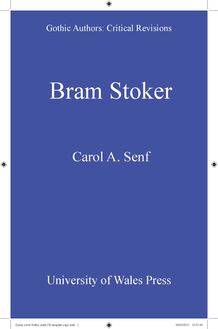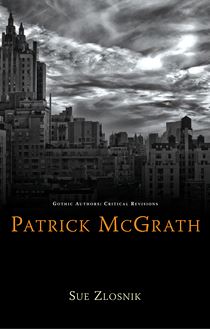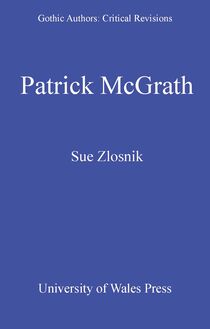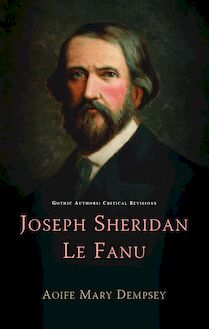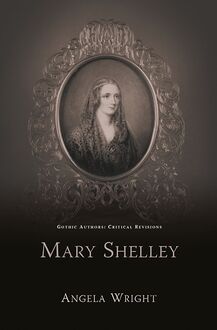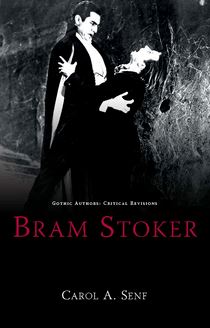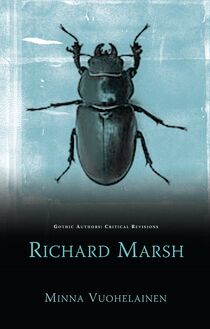-
 Univers
Univers
-
 Ebooks
Ebooks
-
 Livres audio
Livres audio
-
 Presse
Presse
-
 Podcasts
Podcasts
-
 BD
BD
-
 Documents
Documents
-
- Cours
- Révisions
- Ressources pédagogiques
- Sciences de l’éducation
- Manuels scolaires
- Langues
- Travaux de classe
- Annales de BEP
- Etudes supérieures
- Maternelle et primaire
- Fiches de lecture
- Orientation scolaire
- Méthodologie
- Corrigés de devoir
- Annales d’examens et concours
- Annales du bac
- Annales du brevet
- Rapports de stage
La lecture à portée de main
Vous pourrez modifier la taille du texte de cet ouvrage
Découvre YouScribe en t'inscrivant gratuitement
Je m'inscrisDécouvre YouScribe en t'inscrivant gratuitement
Je m'inscrisEn savoir plus
Vous pourrez modifier la taille du texte de cet ouvrage
En savoir plus

Description
This book considers the fiction of Joseph Sheridan Le Fanu (1814–73) in its original material and cultural contexts of the early-to-mid Victorian period in Ireland. Le Fanu’s longstanding relationship with the Dublin University Magazine, a popular literary and political journal, is crucial in the examination of his work; likewise, his fiction is considered as part of a wider surge of supernatural, historical and antiquarian activity by Irish Protestants in the period following the Act of Union between Great Britain and Ireland (1801). This study discusses in detail Le Fanu’s habit of writing and re-writing stories – a practice that has engendered much confusion and consternation – while posthumous collections of his work are compared with original publications to demonstrate the importance of these material and cultural contexts. In new critical readings of aspects of Le Fanu’s best-known fiction, light is cast on some of his overlooked work through recontextualisation.
Acknowledgements
Introduction: Irish Protestant Gothic and J. S. Le Fanu
1. Material Culture, Serialisation and Lateral Reading: Le Fanu’s Short Stories in Context
2. Immaterial Spaces: Le Fanu’s Unhomely Houses
3. Fictional Networks: Le Fanu’s Literary Legacy
4. Le Fanu and the Pitfalls of Posthumous Collections
Closing the Book on the Invisible Prince
Appendix
Bibliography
Notes
Sujets
Informations
| Publié par | University of Wales Press |
| Date de parution | 15 janvier 2022 |
| Nombre de lectures | 0 |
| EAN13 | 9781786838292 |
| Langue | English |
Informations légales : prix de location à la page 0,4400€. Cette information est donnée uniquement à titre indicatif conformément à la législation en vigueur.
Extrait
JOSEPH SHERIDAN LE FANU
SERIES PREFACE
Gothic Authors: Critical Revisions is dedicated to publishing innovative introductory guides to writers of the Gothic. The series explores how new critical approaches and perspectives can help us to recontextualize an author’s work in a way that is both accessible and informative. The series publishes work that is of interest to students of all levels and teachers of the literary Gothic and cultural history.
SERIES EDITORS
Andrew Smith, University of Sheffield
Benjamin Fisher, University of Mississippi
EDITORIAL BOARD
Kent Ljungquist, Worcester Polytechnic Institute, Massachusetts
Richard Fusco, St Joseph’s University, Philadelphia
David Punter, University of Bristol
Angela Wright, University of Sheffield
Jerrold E. Hogle, University of Arizona
GOTHIC AUTHORS: CRITICAL REVISIONS
Joseph Sheridan Le Fanu
Aoife Mary Dempsey
© Aoife Mary Dempsey, 2022
All rights reserved. No part of this book may be reproduced in any material form (including photocopying or storing it in any medium by electronic means and whether or not transiently or incidentally to some other use of this publication) without the written permission of the copyright owner. Applications for the copyright owner’s written permission to reproduce any part of this publication should be addressed to the University of Wales Press, University Registry, King Edward VII Avenue, Cathays Park, Cardiff, CF10 3NS.
www.uwp.co.uk
British Library CIP Data
A catalogue record for this book is available from the British Library
ISBN 978-1-78683-827-8
eISBN 978-1-78683-829-2
The right of Aoife Mary Dempsey to be identified as author of this work has been asserted in accordance with sections 77 and 79 of the Copyright, Designs and Patents Act 1988.
The publisher has no responsibility for the persistence or accuracy of URLs for any external or third-party internet websites referred to in this book, and does not guarantee that any content on such websites is, or will remain, accurate or appropriate.
For my family
C ONTENTS
Acknowledgements
Introduction: Irish Protestant Gothic and J. S. Le Fanu
1 Material Culture, Serialisation and Lateral Reading: Le Fanu’s Short Stories in Context
2 Immaterial Spaces: Le Fanu’s Unhomely Houses
3 Fictional Networks: Le Fanu’s Literary Legacy
4 Le Fanu and the Pitfalls of Posthumous Collections
Closing the Book on The Invisible Prince
Appendix
Notes
Bibliography
Acknowledgements
What began as a cautious daydream about the possibility of a book on Le Fanu has somehow developed into a reality, and I have many people to thank for their support in the realisation of this reverie. First and foremost, my thanks go to the University of Wales Press for agreeing to publish a monograph on Le Fanu. While I steadfastly believe in his enduring brilliance and find him eternally interesting, I realise that not everyone shares this fascination, so I sincerely thank those at the Press for their recognition of Le Fanu’s merit. I think most will agree that Gothic Authors: Critical Revisions is the perfect context for a timely revival of Le Fanu and his work. I hope I have done him justice. In particular, I wish to thank Sarah Lewis and the series editors for their help throughout the entire process, and Professor William Hughes for his warm and helpful feedback during the peer review stage.
My thanks to Professor Eve Patten for her continued support, not least her insistence that I attempt a book, which was the push I needed to start thinking seriously about the project. Thanks also to my former supervisor, Dr Jarlath Killeen, who probably never wants to hear the words ‘Le Fanu’ from me ever again – though I cannot promise that this will be the last time. Thanks as always for your eternal wisdom.
My sincere thanks to my esteemed colleagues and dear friends, Dr Gavin Doyle, Dr Jonny Johnston, Dr Jane Mahony, and particularly Dr Stephen O’Neill, for delighting in conversations about the intricacies of citation (that nobody else would ever tolerate) and for enduring my bouts of existential despair as together we navigated the perils of a global pandemic. As always, your friendship has carried me through.
And finally, my thanks go to my loving family, my mother Terry and brother Jack, who never seem to run out of ways to support and encourage me. I dedicate this book to you.
Aoife Dempsey, Dublin
Introduction: Irish Protestant Gothic and J. S. Le Fanu
Le Fanu Road runs for less than a mile between the west Dublin suburbs of Ballyfermot and Chapelizod, just south of the bifurcating River Liffey. The nomenclature of the streets of Dublin immortalise typically the men of the Irish War of Independence ( c .1916–21), as well as other great leaders, political figures and peers of the eighteenth and nineteenth centuries: O’Connell, Parnell, Wolfe Tone, Henry Moore, earl of Drogheda (who has no fewer than five streets in his name). 1 Even the little-known John Foster – first Baron Oriel and Speaker of the Irish Parliament, one of the few opposed to the Act of Union in 1801 – is remembered in the name of a small side street off College Green: Foster Place. What is less typical of Dublin street names, surprisingly, is the commemoration of Irish authors and artists. Joseph Thomas Sheridan Le Fanu is one of the few to be remembered in such a way, though it is difficult to say whether the people who traverse the thoroughfare of Le Fanu road are all that familiar with its namesake. A prolific author right up to his death in 1873, Le Fanu was among the vanguard of Irish Protestant political and artistic life in the mid-to-late nineteenth century, yet his legacy is largely confined to the academic sphere and the lay consumer of Victorian ghost stories. Though not a politician, Le Fanu was always adjacent to the political fray of nineteenth-century Ireland, being a close personal friend of Isaac Butt, who became leader of the Irish Home Rule League, and of John Mitchell and Thomas Francis Meagher, leaders of the Young Ireland rebellion of 1848, amongst many others. Le Fanu was also a leading figure of the Irish press at the time, owning several newspapers throughout his lifetime, as well as being owner and editor of the eminent periodical, the Dublin University Magazine: A Literary and Philosophical Journal , for almost a decade. 2 Despite all of this, and the remarkable quality of his writing, Le Fanu remains a regrettably overlooked author.
Le Fanu’s fiction, particularly that set in Ireland, is better understood as part of a wider surge of supernatural, historical and antiquarian activity by Irish Protestants in the period following the Act of Union between Great Britain and Ireland (enacted in 1801). His fiction is also influenced in part by European interest in folklore and Gothic themes and objects, but also shaped by the crystallisation of Irish Protestant identity that occurred in the wake of the Act. Communal or shared identity can undergo many changes over time; the evolution of Irish Protestant identity in Ireland is certainly one of the more complex metamorphoses. Following the United Irishmen rebellion of 1798 and subsequent Act of Union, Ireland was obliged to reconfigure political, cultural and national boundaries due to its legislative assimilation as part of Great Britain, which, as the century wore on, became crystallised along sectarian lines. 3 Historians have pointed to the 1798 uprising and subsequent union as a watershed moment in Irish history in which ‘sharpening political divides’ put an end to the ‘old allegiances’ of high and low culture, and cross-sectarian patronage. 4 The closure of the Irish Parliament and the removal of any governmental authority inevitably reawakened the challenges of controlling the adversarial space between England and Ireland, between coloniser and colonised. Consequently, post-Union Irish Protestants turned to imaginative means to satisfy the need for self-inscription. Their self-identification as a minority enclave was defined by their shared religion and a history of settlement in Ireland, coupled with a budding Irish Protestant nationalism, particularly in the immediate post-union period. Irish Protestants in the nineteenth century were abruptly required to negotiate a complicated politics of identity from a place of ‘difference and otherness’. 5
‘Otherness’ is not reserved exclusively for faraway places. Anachronistic otherness existed across Europe as a split of modernity, encapsulated primarily by the urban-rural divide. Related to this societal and class-based split, the emergence of the museum in the late eighteenth century was a significant moment in the colonial history of the world. Oona Frawley contends that the museum was ‘a signifier of European attitudes towards both the natural and cultural world’. As Europeans attempted to ‘classify and systematize all things natural’, the result was a parallel interest in ‘displaying the findings for scientific study’. 6 The collection and display of the past, then, promotes this shared culture and links it to a common history that helps consolidate shared identity in the present. The collation of folk culture was a widespread, popular activity across Europe and in Ireland, particularly in the late eighteenth and early nineteenth century. Learned societies such as the Royal Dublin Society (1731) and the Royal Irish Academy (1785) were established as institutions of colonial knowledge. Elizabeth Tilley defines the academy’s ‘antiquarian role’ in collecting ‘precious objects – everything from gold ornaments to ogham stones’, which eventually ‘formed the nucleus’ of the National Museum of Ireland when it opened in 1877. 7 While museums contained material remnants of the past, folk stories and popular antiquities facilitated fictional articulations of culture in a similar way, serving as important functions of cultural consolidation. The activity of gathering and preserving for pos
-
 Univers
Univers
-
 Ebooks
Ebooks
-
 Livres audio
Livres audio
-
 Presse
Presse
-
 Podcasts
Podcasts
-
 BD
BD
-
 Documents
Documents
-
Jeunesse
-
Littérature
-
Ressources professionnelles
-
Santé et bien-être
-
Savoirs
-
Education
-
Loisirs et hobbies
-
Art, musique et cinéma
-
Actualité et débat de société
-
Jeunesse
-
Littérature
-
Ressources professionnelles
-
Santé et bien-être
-
Savoirs
-
Education
-
Loisirs et hobbies
-
Art, musique et cinéma
-
Actualité et débat de société
-
Actualités
-
Lifestyle
-
Presse jeunesse
-
Presse professionnelle
-
Pratique
-
Presse sportive
-
Presse internationale
-
Culture & Médias
-
Action et Aventures
-
Science-fiction et Fantasy
-
Société
-
Jeunesse
-
Littérature
-
Ressources professionnelles
-
Santé et bien-être
-
Savoirs
-
Education
-
Loisirs et hobbies
-
Art, musique et cinéma
-
Actualité et débat de société
- Cours
- Révisions
- Ressources pédagogiques
- Sciences de l’éducation
- Manuels scolaires
- Langues
- Travaux de classe
- Annales de BEP
- Etudes supérieures
- Maternelle et primaire
- Fiches de lecture
- Orientation scolaire
- Méthodologie
- Corrigés de devoir
- Annales d’examens et concours
- Annales du bac
- Annales du brevet
- Rapports de stage
